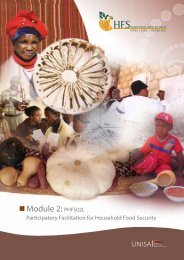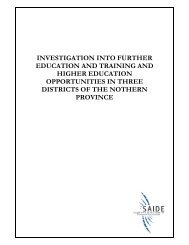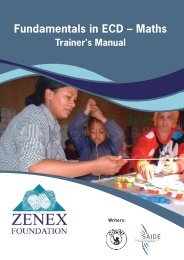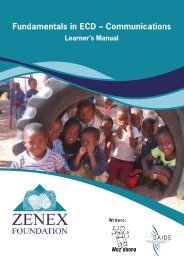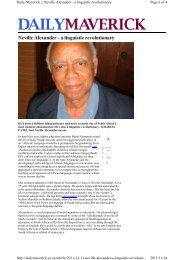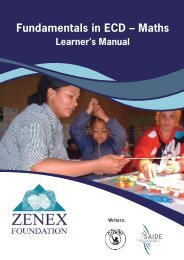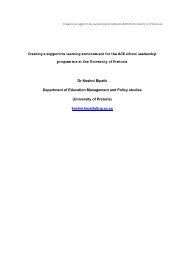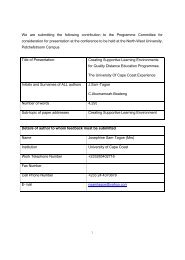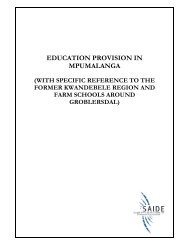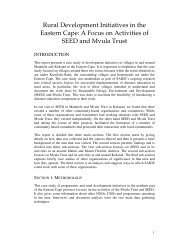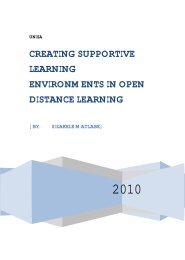1 a comparison of the advantages and disadvantages of satellite ...
1 a comparison of the advantages and disadvantages of satellite ...
1 a comparison of the advantages and disadvantages of satellite ...
Create successful ePaper yourself
Turn your PDF publications into a flip-book with our unique Google optimized e-Paper software.
A COMPARISON OF THE ADVANTAGES AND DISADVANTAGES OF SATELLITE BROADCASTS, VIDEO<br />
CONFERENCING AND DISCUSSION CLASSES IN ODL: A CASE STUDY IN THE COLLEGE OF HUMAN<br />
SCIENCES, UNISA<br />
1. INTRODUCTION<br />
Marietha Nieman<br />
Modern technology allows lecturers <strong>and</strong> students in a distance education institution to interact<br />
effectively even though individuals are far apart. Video conferencing (VC) <strong>and</strong> <strong>satellite</strong> broadcasts<br />
(SB) in particular are two types <strong>of</strong> distance learning technology that can enhance <strong>the</strong> student’s<br />
capacity to engage in learning in a variety <strong>of</strong> ways. Both allow for a centrally-based lecturer to<br />
engage with multiple students in one or more decentralised venues. Both require lecturers <strong>and</strong><br />
students to be in a particular place at a particular time (thus reducing some <strong>of</strong> <strong>the</strong> flexibility <strong>of</strong><br />
distance education study) but costs <strong>of</strong> travel are curtailed since not everybody has to travel to a<br />
central venue. In case <strong>of</strong> <strong>satellite</strong> broadcasts it is possible to record <strong>the</strong> sessions <strong>and</strong> make <strong>the</strong><br />
recordings available at <strong>the</strong> regional centres for students unable to participate at <strong>the</strong> scheduled time.<br />
2 VENUES<br />
2.1 Videoconferencing<br />
At Unisa <strong>the</strong> venues for video conferencing (with <strong>the</strong> number <strong>of</strong> students <strong>the</strong> venue can<br />
accommodate given in brackets) are as follows:<br />
Pretoria Muckleneuk (7); Pretoria Muckleneuk (25); Pretoria Muckleneuk (10); Pretoria Sunnyside<br />
(40); Florida (50); Durban (62); Cape Town/Parow (35); Polokwane (25); Port Elizabeth (25) (although<br />
this venue has been out <strong>of</strong> commission for two years due to an impasse between <strong>the</strong> central campus<br />
<strong>and</strong> regional <strong>of</strong>fice over security arrangements); East London (15); Mafikeng (20); Kimberley (10);<br />
Pietermaritzburg (10); Bloemfontein (18); Nelspruit (12); Middelburg (30); New Castle (25); Umtata<br />
(25); Benoni (20); Johannesburg (35); Rustenburg (40). Total: 539.<br />
It should, however, be noted that it is extremely difficult to accommodate more than six regional<br />
venues during one video conference. The lecturer is able to see <strong>the</strong> students in <strong>the</strong> different venues<br />
on a screen in <strong>the</strong> studio. The more venues that are linked to <strong>the</strong> central venue, <strong>the</strong> smaller <strong>the</strong><br />
image <strong>of</strong> <strong>the</strong> venues become on <strong>the</strong> screen. It also takes good organising skills to h<strong>and</strong>le more than 6<br />
venues at a time. This suggests that <strong>the</strong> facilities are best used for targeted, complementary<br />
interventions ra<strong>the</strong>r than mainstream, core teaching <strong>and</strong> that additional measures need to be taken<br />
to support students who needed to participate but were unable to at <strong>the</strong> scheduled times.<br />
2.2 Satellite broadcasts<br />
Venues for <strong>satellite</strong> broadcasts (with <strong>the</strong> number <strong>of</strong> students that can be accommodated given in<br />
brackets) are as follows:<br />
1
Florida (50); Sunnyside (125); Johannesburg (125); Benoni (20); Durban (25); Durban (100);<br />
Pietermaritzburg (200; Newcastle (15); Nelspruit (50); Middelburg (20); Bloemfontein (20); Mafikeng<br />
(30); Klerksdorp (50); Rustenburg (20); Potchefstroom (20); Kimberley (25); Upington (25);<br />
Polokwane (35); East London (20); Port Elizabeth (20); Umtata (25); Cape Town/Parow (40); George<br />
(20); Stellenbosch (20); Worcester (12); Windhoek (25). Total: 957.<br />
3 THE RESEARCH PROCESS<br />
CODs were contacted by e-mail or telephone with a request to identify lecturers in <strong>the</strong>ir<br />
departments who make use <strong>of</strong> ei<strong>the</strong>r VC or SB facilities. Individual <strong>and</strong> focus group interviews were<br />
<strong>the</strong>n arranged with a r<strong>and</strong>om selection <strong>of</strong> lecturers identified by <strong>the</strong>ir COD. A total number <strong>of</strong> 21<br />
lecturers were interviewed. Of <strong>the</strong>se, five lecturers (all from <strong>the</strong> same department) were<br />
interviewed with regard to SBs <strong>and</strong> 16 with regard to VCs.<br />
The following questions were asked:<br />
1. Do you make use <strong>of</strong> <strong>satellite</strong> broadcasts or video conferencing?<br />
2. Why did you choose to use <strong>the</strong> one <strong>and</strong> not <strong>the</strong> o<strong>the</strong>r?<br />
3. How many times a year/semester do you use <strong>the</strong> facility?<br />
4. Who initiated <strong>the</strong> use?<br />
5. What is <strong>the</strong> service like?<br />
6. What problems did you experience?<br />
7. Did you get any feedback from students with regard to <strong>the</strong> use <strong>of</strong> <strong>the</strong> facility? If “yes”, please<br />
explain.<br />
8. What is <strong>the</strong> main purpose <strong>of</strong> <strong>the</strong> <strong>satellite</strong> broadcast/video conference? (E.g. discussion <strong>of</strong><br />
assignments, examination guidelines, explanation <strong>of</strong> module content, etc.)<br />
9. How is <strong>the</strong> use <strong>of</strong> <strong>the</strong> <strong>satellite</strong> broadcasting/video conferencing integrated into <strong>the</strong> overall<br />
learning experience?<br />
10. How is <strong>the</strong> use <strong>of</strong> <strong>satellite</strong> broadcasting/ video conferencing evaluated?<br />
11. What worked/works well?<br />
12. What did not work/works well?<br />
13. Do you hold face-to-face discussion classes? What are <strong>the</strong> relative<br />
<strong>advantages</strong>/dis<strong>advantages</strong> <strong>of</strong> discussion classes over <strong>satellite</strong> broadcasting or video<br />
conferencing?<br />
If necessary, follow-up questions were asked.<br />
With <strong>the</strong> permission <strong>of</strong> <strong>the</strong> participants, <strong>the</strong> interviews were recorded <strong>and</strong> digital recordings are<br />
available if required.<br />
4 FINDINGS<br />
4.1 Do you make use <strong>of</strong> <strong>satellite</strong> broadcasts or video conferencing?<br />
Of <strong>the</strong> 27 departments in <strong>the</strong> College <strong>of</strong> Human sciences 13 make use <strong>of</strong> video conferencing. ). Two<br />
departments make use <strong>of</strong> video conferencing in all <strong>the</strong> modules that are <strong>of</strong>fered, whereas o<strong>the</strong>r<br />
departments use this facility in some but not all <strong>the</strong> modules. Sometimes it is used by as little as two<br />
modules <strong>of</strong>fered in <strong>the</strong> department. Only one department makes use <strong>of</strong> <strong>satellite</strong> broadcasts. It<br />
2
should, however, be noted that this facility is used in all <strong>the</strong> undergraduate modules <strong>and</strong> most <strong>of</strong> <strong>the</strong><br />
Honours modules <strong>of</strong>fered by <strong>the</strong> department. 14 departments do not make use <strong>of</strong> any <strong>of</strong> <strong>the</strong><br />
facilities.<br />
Reasons cited for not using <strong>the</strong> facilities:<br />
Used video conferencing up to 2008 but discontinued it because <strong>of</strong> poor attendance or a<br />
“no-show”.<br />
Students are scattered all over <strong>the</strong> world <strong>and</strong> can’t be reached by means <strong>of</strong> VC or SB.<br />
<br />
<br />
<br />
<br />
<br />
Prefer to do discussion classes.<br />
Student numbers are too low.<br />
Student numbers are too high <strong>and</strong> <strong>the</strong>refore <strong>the</strong> discussion class option is preferred.<br />
Students live in remote rural areas. Tutors meet students once a month. The type <strong>of</strong><br />
students in particular programmes (e.g. ABET students) prefer face-to-face contact.<br />
Prefer face-to-face workshops. These are better options for addressing more practical<br />
activities in which lecturers need to respond to a variety <strong>of</strong> cues. An element <strong>of</strong> face-to-face<br />
interaction is considered necessary for pr<strong>of</strong>essional development in a field based on interpersonal<br />
interaction (e.g. in Social Work).<br />
Many departments still hold discussion classes, mostly because <strong>of</strong> large numbers <strong>of</strong> students <strong>and</strong><br />
because <strong>the</strong>y prefer to have face-to-face contact with students. Lecturers in <strong>the</strong>se departments<br />
indicated that discussion classes are still <strong>the</strong> preferred method <strong>of</strong> learning facilitation.<br />
4.2 Why did you choose to use <strong>the</strong> one <strong>and</strong> not <strong>the</strong> o<strong>the</strong>r?<br />
Before analysing lecturers’ responses to this question, it should be noted that a number <strong>of</strong> lecturers<br />
were not familiar with <strong>satellite</strong> broadcastings. The concept had to be explained to <strong>the</strong>m before <strong>the</strong>y<br />
could answer <strong>the</strong> question.<br />
Lecturers who make use <strong>of</strong> video conferencing indicated that <strong>the</strong>y prefer it to SBs for <strong>the</strong> following<br />
reasons:<br />
<br />
<br />
<br />
<br />
<br />
<br />
Satellite broadcasts allow for a one-way flow <strong>of</strong> information only as in a traditional teachercentred<br />
lecture, which leaves students passive.<br />
Video-conferencing allows for active participation <strong>and</strong> interaction <strong>and</strong> <strong>the</strong> building <strong>of</strong><br />
relationships with students.<br />
Lecturers prefer a discussion with students. They want to see <strong>the</strong>ir students, facilitate<br />
question <strong>and</strong> answer sessions, have students perform practical activities <strong>and</strong> observe <strong>the</strong>m<br />
when doing so.<br />
In some departments lecturers were not given a choice – <strong>the</strong> department had decided to use<br />
VCs (to replace discussion classes) <strong>and</strong> <strong>the</strong>y had to comply.<br />
VC has been around longer. It has been used by some departments as far back as <strong>the</strong> early<br />
1990s.<br />
Haven’t had <strong>the</strong> capacity to get round to SBs.<br />
3
Lecturers who make use <strong>of</strong> <strong>satellite</strong> broadcasts cited <strong>the</strong> following reasons for <strong>the</strong>ir preference:<br />
<br />
<br />
<br />
<br />
Satellite broadcasts can be rebroadcast - even on Saturdays – which implies that students<br />
who missed a broadcast because <strong>of</strong> o<strong>the</strong>r responsibilities can still be reached.<br />
A DVD can be made <strong>of</strong> <strong>the</strong> presentation. Students can buy it <strong>and</strong> watch it repeatedly in <strong>the</strong>ir<br />
own time.<br />
Satellite broadcasts are more cost-effective than video conferences <strong>and</strong> more regional<br />
centres - <strong>and</strong> <strong>the</strong>refore also more students - can be reached in a single session. Most <strong>of</strong> <strong>the</strong><br />
lecturers were very enthusiastic about <strong>the</strong> <strong>satellite</strong> broadcasts (Dr Elize Terblanche must be<br />
singled out as she is particulary enthusiastic about SBs <strong>and</strong> has also presented a paper on<br />
this topic at an international conference.)<br />
Discussion classes <strong>and</strong> VCs are mostly presented in <strong>the</strong> main regional centres (e.g. Cape<br />
Town, Durban, East London <strong>and</strong> Polokwane) <strong>and</strong> lecturers felt that this is unfair to students<br />
in remote areas. SBs can reach students in all <strong>the</strong> regional centres.<br />
4.3 How many times a year do you use <strong>the</strong> facility?<br />
The use <strong>of</strong> <strong>the</strong> facilities varies from department to department. Lecturers indicated that <strong>the</strong><br />
semester system does not allow <strong>the</strong>m to have more than one session per semester. VCs are usually<br />
scheduled early in <strong>the</strong> semester, which means that students haven’t had time to go through <strong>the</strong>ir<br />
work. They are <strong>the</strong>refore unprepared <strong>and</strong> can’t really take part in <strong>the</strong> group discussion. VCs can’t be<br />
scheduled later in <strong>the</strong> semester, because <strong>the</strong>n students are preparing for examinations.<br />
In year courses <strong>the</strong> facility is mostly used twice a year.<br />
Lecturers who make use <strong>of</strong> SBs indicated that <strong>the</strong> broadcasts are mostly rebroadcast once or twice.<br />
They also prefer presentations to be rebroadcast on a Saturday to give students who work a chance<br />
to attend as well. Students can also buy a copy <strong>of</strong> <strong>the</strong> DVD at R56.00. Regional <strong>of</strong>fices get copies <strong>of</strong><br />
<strong>the</strong> DVDs <strong>and</strong> students who do not have <strong>the</strong> necessary equipment to watch a DVD at home, or can’t<br />
afford <strong>the</strong> DVD, can watch it at <strong>the</strong> regional <strong>of</strong>fice.<br />
Video conferencing allows for a direct link between <strong>the</strong> central studio <strong>and</strong> a number <strong>of</strong> decentralised<br />
centres. Although one department indicated that <strong>the</strong>y h<strong>and</strong>le seven regional centres at a time, o<strong>the</strong>r<br />
departments indicated that <strong>the</strong> split-screen option does not always work. They prefer a direct link<br />
between <strong>the</strong> central studio <strong>and</strong> one centre, because according to <strong>the</strong>m <strong>the</strong> ideal group size is 20 or<br />
less due to <strong>the</strong> active participation required. This is very time-consuming, however, as it implies that<br />
<strong>the</strong> same ‘lecture’ has to be presented many times in order to reach all <strong>the</strong> main centres. In some<br />
cases discussion classes are held in Pretoria, but <strong>the</strong> video conferencing facility is used to reach<br />
students in Durban <strong>and</strong> Cape Town. This implies that only students in <strong>the</strong> main centres are reached<br />
<strong>and</strong> emphasises <strong>the</strong> concern <strong>of</strong> lecturers about VCs <strong>and</strong> discussion classes not being fair to students<br />
in remote areas.<br />
The length <strong>of</strong> <strong>the</strong> sessions varies. Only one department have VC sessions shorter than one hour (40<br />
minutes). VC sessions mostly last from one hour to six hours. Students get short breaks in between<br />
sessions. In some cases one lecturer is responsible for <strong>the</strong> whole session, but in o<strong>the</strong>r cases lecturers<br />
take turns to present different sections <strong>of</strong> a particular module or a different module.<br />
4
SBs mostly last two to three hours, with a short break in between. Lecturers indicated that threehour<br />
sessions are a bit long <strong>and</strong> that students tend to get restless <strong>and</strong> tired. Lecturers also felt<br />
drained after a three-hour session.<br />
VC is also used for assessment purposes in some cases (e.g. Linguistics).<br />
4.4 Why did you decide to make use <strong>of</strong> VCs or SBs?<br />
Especially in <strong>the</strong> smaller departments discussion classes became too expensive <strong>and</strong> <strong>the</strong> department<br />
had to look at alternative methods <strong>of</strong> providing student support <strong>and</strong> making contact with students.<br />
Some <strong>of</strong> <strong>the</strong> lecturers indicated that <strong>the</strong>y got <strong>the</strong> idea that Unisa had acquired <strong>the</strong> facilities at great<br />
cost <strong>and</strong> that lecturers were expected to use <strong>the</strong>m.<br />
It appears that <strong>the</strong> discussion class policy which requires a minimum attendance <strong>of</strong> 20 students for a<br />
particular session has compelled departments to consider alternative ways <strong>of</strong> making contact with<br />
students.<br />
4.5 What problems did you experience?<br />
The most common problems mentioned with regard to video conferencing were <strong>the</strong> following:<br />
<br />
<br />
<br />
<br />
<br />
Video-conferencing facilities are not available in o<strong>the</strong>r African countries such as Botswana,<br />
Ethiopia <strong>and</strong> Mauritius (where Unisa has many students). Lecturers overcome this by making<br />
use <strong>of</strong> teleconferencing, but it is regarded as second best.<br />
There have been occasions when telephone lines have been down at <strong>the</strong> scheduled time or<br />
when connections were broken during <strong>the</strong> conference. Such interruptions waste time <strong>and</strong><br />
students get upset.<br />
Students arrive late <strong>and</strong> because <strong>the</strong> equipment is very sensitive, <strong>the</strong> smallest disruption<br />
creates a lot <strong>of</strong> noise. The equipment is very sensitive <strong>and</strong> amplifies all noises. It <strong>of</strong>ten takes<br />
up to 15 minutes for students to settle down.<br />
Students do not attend sessions – <strong>the</strong> turn-out at some centres is <strong>of</strong>ten very poor <strong>and</strong><br />
according to one lecturer <strong>the</strong>y “<strong>the</strong>n later complain about <strong>the</strong> lack <strong>of</strong> contact”.<br />
Students are camera shy <strong>and</strong> tend not to take part in <strong>the</strong> discussions.<br />
The most common problems experienced with <strong>the</strong> <strong>satellite</strong> broadcasts were <strong>the</strong> following:<br />
<br />
<br />
<br />
<br />
Students do not attend sessions – <strong>the</strong> turn-out at some centres is <strong>of</strong>ten very poor. To<br />
overcome this problem lecturers have arranged for SBs to be rebroadcast on Saturdays.<br />
Satellite broadcasts can reach students in Namibia but not in o<strong>the</strong>r African countries.<br />
It takes time to get used to <strong>the</strong> camera <strong>and</strong> to facilitate a session where no learners are<br />
present.<br />
The DVD is not always available to students (<strong>the</strong> problem apparently lies with Unisa Press).<br />
4.6 Did you get any feedback from students with regard to <strong>the</strong> use <strong>of</strong> <strong>the</strong> facility? If ‘yes’, please<br />
explain.<br />
5
For both <strong>satellite</strong> <strong>and</strong> video conferencing <strong>the</strong> feedback received was informal. In <strong>the</strong> case <strong>of</strong> video<br />
conferencing <strong>the</strong> feedback mostly included comments at <strong>the</strong> end <strong>of</strong> a session to <strong>the</strong> effect that<br />
students would have liked to continue <strong>the</strong> session/ were reluctant to leave; emails or postings on<br />
myUnisa commenting on how useful <strong>the</strong> session had been were also received.<br />
According to lecturers <strong>the</strong> feedback from students is mostly positive. However, <strong>the</strong>re were<br />
complaints about overcrowding at facilities. In Social Work this resulted in <strong>the</strong> splitting <strong>of</strong> groups at<br />
<strong>the</strong> larger centres into smaller groups.<br />
A few students still express a preference for direct face-to-face contact with <strong>the</strong> responsible lecturer.<br />
4.7 What works well?<br />
Video conferencing<br />
<br />
<br />
<br />
<br />
<br />
<br />
<br />
It is noted that video-conferencing works for small group discussions but requires good<br />
facilitation skills in order to encourage full participation. Some lecturers indicated that videoconferencing<br />
does not work well for more practical activities such as role plays where it is<br />
necessary to be able to pick up on emotional cues etc., but o<strong>the</strong>r lecturers contradicted this<br />
observation.<br />
Visuals<br />
Good planning <strong>and</strong> preparation. It was suggested that one should book <strong>and</strong> plan well in<br />
advance.<br />
Informing students at <strong>the</strong> beginning <strong>of</strong> <strong>the</strong> session how <strong>the</strong> facility works <strong>and</strong> putting<br />
students at ease.<br />
Having a “monitor/class captain/spokesperson” in <strong>the</strong> regional centre to organise students.<br />
Having one person in <strong>the</strong> department responsible for h<strong>and</strong>ling all administrative issues,<br />
bookings <strong>and</strong> sorting out problems.<br />
Good support in <strong>the</strong> regional centres. It was suggested that tutors be used to make <strong>the</strong><br />
students feel at home first.<br />
Satellite broadcasts<br />
<br />
<br />
<br />
<br />
<br />
<br />
<br />
Explaining to students what a <strong>satellite</strong> broadcast is <strong>and</strong> how <strong>the</strong> facility works. This should<br />
also be done in tutorial letters with time tables for SBs.<br />
Regular activity breaks<br />
Variation, not only in terms <strong>of</strong> method <strong>of</strong> presentation but also variation <strong>of</strong> lecturers who<br />
present.<br />
Good planning <strong>and</strong> preparation<br />
Visuals (e.g. Power Point Presentation) with not too much text on <strong>the</strong> PPP.<br />
A lively presenter who knows his./her study material very well.<br />
A panel discussion between a group <strong>of</strong> lecturers (this takes a lot <strong>of</strong> preparation, but works<br />
extremely well).<br />
4.8 What does not work?<br />
6
Video conferencing<br />
<br />
<br />
Physical constraints have been noted above.<br />
Long sessions without any breaks are problematic.<br />
Satellite broadcasts<br />
<br />
Power point presentations with too much text <strong>and</strong>/or a very small letter font.<br />
4.9 Do you make use <strong>of</strong> face-to-face classes? What are <strong>the</strong> relative <strong>advantages</strong>/<br />
dis<strong>advantages</strong> <strong>of</strong> discussion classes over <strong>satellite</strong> broadcasts or video conferencing?<br />
Face-to-face discussion classes are still <strong>the</strong> preferred method <strong>of</strong> learning facilitation for most<br />
lecturers. The perceived <strong>advantages</strong> <strong>and</strong> dis<strong>advantages</strong> <strong>of</strong> <strong>the</strong> three delivery modes can be<br />
summarised as follows:<br />
Delivery mode Advantages Dis<strong>advantages</strong><br />
DC Direct contact with students<br />
(can observe <strong>and</strong> “read” target<br />
group).<br />
<br />
<br />
<br />
<br />
<br />
<br />
<br />
More dynamic.<br />
More interactive.<br />
Can continue discussions with<br />
individual students after class.<br />
Students can show you what<br />
<strong>the</strong>ir problem is (e.g. an<br />
assignment that has been<br />
marked incorrectly).<br />
More personal. Students can<br />
identify with/relate to <strong>the</strong><br />
lecturer.<br />
More students attend<br />
discussion classes than VCs or<br />
SBs.<br />
Students prefer face-to-face<br />
discussion classes.<br />
CV Cost-effective (not as expensive<br />
as discussion classes).<br />
A good, but second best,<br />
alternative to discussion<br />
classes.<br />
More interactive than <strong>satellite</strong><br />
<br />
<br />
<br />
<br />
<br />
<br />
<br />
<br />
<br />
<br />
Are presented only at main<br />
regional centres <strong>and</strong> <strong>the</strong>refore<br />
not all students are reached<br />
(unfair).<br />
Time consuming.<br />
Lecturers are out <strong>of</strong> <strong>the</strong>ir<br />
<strong>of</strong>fices for a long time.<br />
Expensive.<br />
Once a DC is over it is over. No<br />
DVD that students can watch<br />
afterwards.<br />
Venues are <strong>of</strong>ten overcrowded<br />
<strong>and</strong> facilities inadequate.<br />
Some students are intimidated<br />
by <strong>the</strong> technology.<br />
Can be very noisy.<br />
Can reach only a few regional<br />
centres in one session.<br />
Mostly only <strong>the</strong> main regional<br />
7
oadcasts.<br />
SB Cost-effective (not as expensive<br />
as discussion classes <strong>and</strong> even<br />
cheaper than VC).<br />
Cost-effective for students as<br />
<strong>the</strong>y do not need to travel to<br />
<strong>the</strong> main regional centres.<br />
Can reach more students.<br />
<br />
<br />
<br />
Can be rebroadcast.<br />
A DVD <strong>of</strong> <strong>the</strong> presentation can<br />
be made for students to view<br />
at a later stage.<br />
Copies <strong>of</strong> <strong>the</strong> previous year’s<br />
DVDs are given to new staff<br />
<strong>and</strong> are used to train <strong>the</strong>m.<br />
<br />
<br />
<br />
<br />
<br />
<br />
<br />
<br />
centres are accommodated.<br />
Time consuming, because <strong>the</strong><br />
same lecture has to be<br />
presented to different regions.<br />
Turn out not always very good.<br />
(Students would ra<strong>the</strong>r attend<br />
discussion classes.)<br />
Split-screen does not always<br />
work <strong>and</strong> <strong>the</strong>refore <strong>the</strong> same<br />
discussion class has to be<br />
presented several times to<br />
reach students in <strong>the</strong> regional<br />
centres.<br />
Lecturer cannot see students.<br />
Limited interaction.<br />
Some students are intimidated<br />
by <strong>the</strong> technology.<br />
DVDs are not always available<br />
to students (<strong>of</strong>ten out <strong>of</strong><br />
stock).<br />
Turn out not always very good.<br />
(Students prefer discussion<br />
classes.)<br />
5 CONCLUSION AND RECOMMENDATION<br />
Although <strong>satellite</strong> broadcasts <strong>and</strong> video conferencing have many <strong>advantages</strong> <strong>and</strong> are a good<br />
substitute for some kinds <strong>of</strong> discussion classes, most <strong>of</strong> <strong>the</strong> lecturers that were interviewed indicated<br />
that <strong>the</strong>se facilities are second best <strong>and</strong> that <strong>the</strong>y would still prefer discussion classes. It, however,<br />
seems that financial constraints have forced <strong>the</strong>m to resort to <strong>the</strong> use <strong>of</strong> SBs <strong>and</strong> VCs.<br />
In all three modalities, <strong>the</strong> potential for interaction can only be realised if <strong>the</strong> session has been<br />
designed in this way from <strong>the</strong> beginning. The use <strong>of</strong> any <strong>of</strong> <strong>the</strong>se strategies simply for <strong>the</strong><br />
transmission <strong>of</strong> content – <strong>of</strong>fering potted summaries <strong>of</strong> <strong>the</strong> course materials – will only encourage<br />
cramming <strong>and</strong> surface learning. Ideally, <strong>the</strong> use <strong>of</strong> any <strong>of</strong> <strong>the</strong>se approaches needs to be designed<br />
into <strong>the</strong> programme/module delivery with clear pre-, during <strong>and</strong> post-activities. Strategies need also<br />
to be agreed for feedback to students who were unable to participate on <strong>the</strong> scheduled dates. Core<br />
learning resources/experiences MUST be delivered/mediated in ways that reach all <strong>the</strong> students.<br />
Therefore <strong>the</strong> programme/module design process needs to be informed by <strong>the</strong> learner pr<strong>of</strong>ile.<br />
8
The use <strong>of</strong> VCs <strong>and</strong> SBs should form an integral part <strong>of</strong> <strong>the</strong> module - it should not be an add-on. This<br />
implies that VCs <strong>and</strong> SBs should be taken into consideration when designing, developing <strong>and</strong> revising<br />
modules.<br />
I would like to acknowledge Tony Mays’ help with <strong>the</strong> research project.<br />
9



